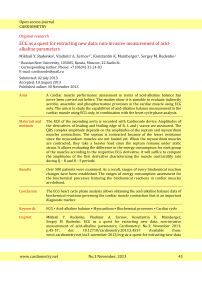ECG as a quest for extracting new data: non-invasive measurement of acid-alkaline parameters
Автор: Rudenko Mikhail Y., Zernov Vladimir A., Mamberger Konstantin, Rudenko Sergey M.
Журнал: Cardiometry @cardiometry
Рубрика: Original research
Статья в выпуске: 3, 2013 года.
Бесплатный доступ
Aims A cardiac muscle performance assessment in terms of acid-alkaline balance has never been carried out before. The studies show it is possible to evaluate indirectly aerobic, anaerobic and phosphocreatine processes in the cardiac muscle using ECG only. The aim is to study the capabilities of acid-alkaline balance measurement in the cardiac muscle using ECG only, in combination with the heart cycle phase analysis. Materials and methods The ECG of the ascending aorta is recorded with Cardiocode device. Amplitudes of the derivatives of leading and trailing edge of R, L and j waves are measured. The QRS complex amplitude depends on the amplitudes of the septum and myocardium muscles contractions. The septum is contracted because of the lesser resistance since the myocardium muscles are not loaded yet. When the myocardium muscles are contracted, they take a heavier load since the septum remains under static strain. It allows evaluating the difference in the energy consumption for each group of the muscles according to the respective ECG derivative...
Acid-alkaline balance, biochemical processes, cardiac cycle, ecg, myocardium
Короткий адрес: https://sciup.org/148308743
IDR: 148308743
Список литературы ECG as a quest for extracting new data: non-invasive measurement of acid-alkaline parameters
- Dushanin SA. Advanced methods for investigation of energy metabolism in muscles performance. Kiev1984.
- Dushanin S. System for multi-factor express diagnostics of sportsmen functional conditioning under current operative medical & pedagogic control. Kiev1986.
- Rudenko MY, Zernov VA, Voronova O.K. Fundamental Research on the Mechanism of Cardiovascular System Hemodynamics Self-Regulation and Determination of the Norm-Pathology Boundary for the Basic Hemodynamic Parameters and Analysis of the Compensation Mechanism as a Method of Revealing the Underlying Causes of the Disease. Heart Rhythm. November 2012;9(11):1909 DOI: 10.1016/j.jelectrocard.2013.09.016
- Rudenko MY, Zernov VA, Voronova O.K. Study of Hemodynamic Parameters Using Phase Analysis of the Cardiac Cycle. Biomedical Engineering. July 2009;43(4):151-5.
- Rudenko M, Zernov V, Voronova O, Rudenko S, Mamberger K, D. M. Periodic table ECG phase changes (electrocardiography basics). ISBN 978-5-86746-116-5, Mosсow2013.
- Chapleau MW. Baroreceptor Reflexes (book chapter). Primer on the Autonomic Nervous System2012:161-165 DOI: 10.1016/B978-0-12-386525-0.00033-0
- Garkavi L. Activation therapy. ISBN 5-7507-0179-4, Rostov-on-Don: Rostov State University; 2006.
- Kenny D, Polson JW, Martin RP, Caputo M, Wilson DG, Cockcroft JR, et al. Relationship of aortic pulse wave velocity and baroreceptor reflex sensitivity to blood pressure control in patients with repaired coarctation of the aorta. American Heart Journal. August 2011;162(2):398-404.
- La Rovere MT, Maestri R, Pinna GD. Baroreflex sensitivity assessment -latest advances and strategies. Interventional Cardiology (London). 2012;7(2):89-92.
- Morrisona SF, Barmana SM, Gebber GL. Baroreceptor influences on cardiac-related sympathetic nerve activity. Brain Research. 28 May 1984;301(1):175-8.
- Sleight P. Reflex control of the heart. The American Journal of Cardiology. 22 October 1979;44(5):889-94.


